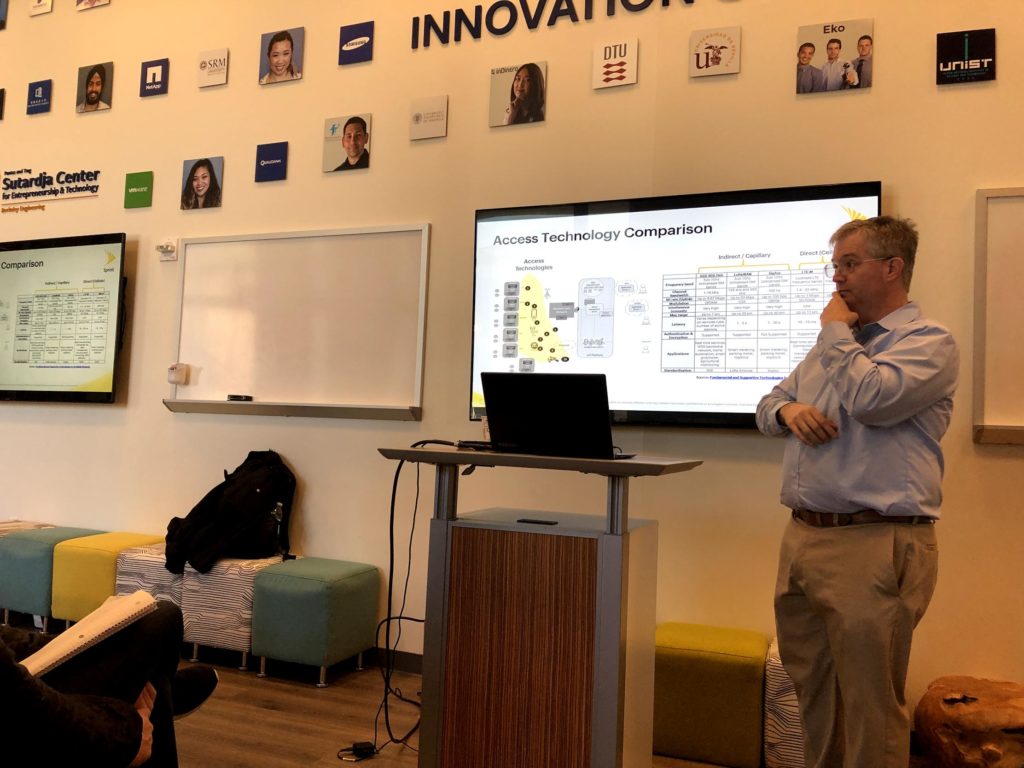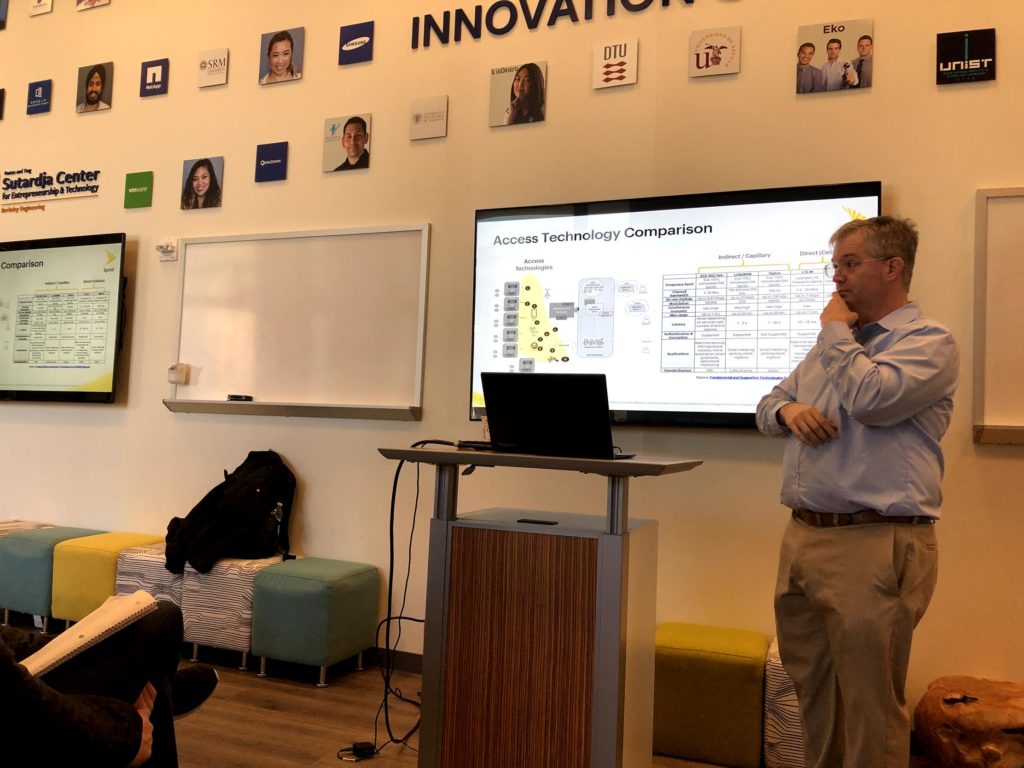

This week in Innovation Engineering, Lyle Bertz, who leads R&D at Sprint came to speak to the class about 5G and IoT. The session helped students understand the network and how it affects IoT.
Here are a few key outtakes from his presentation:
1. IoT will change network behavior. Currently, most networks are configured for heavy downloads (like watching movies) and light uploads. With IoT, this may change to millions of devices producing information instead of consuming information.
2. The cost of the 5G chip maybe 10X that of Wifi. (i.e. $20-30 vs $2-3). For this reason, the IoT strategy for 5G does not need to have every device use a 5G chipset. Instead, Wifi devices will continue to be the more common IoT device, particularly for indoor and fixed applications. However, the 5G standard has opened an interface for wifi IoT devices to talk to functions within the network that will let them add themselves to groups that may require all to map to a single sim card.
3. The standards specifically allow for a new Wifi Router in which the access to the Internet (backhaul to WAN) is provided through 5G. This may change how people get Internet access. We still believe that the router may get value from peer to peer 5G connections to improve coverage and the newly emerging deployment issues.
4. There is a tradeoff between reliability and low latency. Also, the 1 mS latency is only between cell phone towers and does not count other parts of the Internet delay, which can be easily increased from 50 to 200 mS.
5. In 5G, the network often separates bandwidth and signaling resources for different uses. In the case of 5G, the most common expected slices might not be per customer but by function, such as voice, data, or enterprise application.
Overall, this was a great way to get better insight and synthesize information for new research project concepts and modern applications – which the class is currently doing. To find out more, view the presentation here.
Background: The Innovating 5G with AI Course uses the Innovation Engineering framework developed at UC Berkeley to apply technology and create transformation by aligning human talent in an efficient, effective, and positive manner. This framework offers practical guidance for how – large firms, research labs, new ventures, and even student projects can execute their innovation projects and make their ideas a reality. Interested in learning more? Check out innovation-engineering.net and read Professor Sidhu‘s new book: Innovation Engineering.


This week in Innovation Engineering, Lyle Bertz, who leads R&D at Sprint came to speak to the class about 5G and IoT. The session helped students understand the network and how it affects IoT.
Here are a few key outtakes from his presentation:
1. IoT will change network behavior. Currently, most networks are configured for heavy downloads (like watching movies) and light uploads. With IoT, this may change to millions of devices producing information instead of consuming information.
2. The cost of the 5G chip maybe 10X that of Wifi. (i.e. $20-30 vs $2-3). For this reason, the IoT strategy for 5G does not need to have every device use a 5G chipset. Instead, Wifi devices will continue to be the more common IoT device, particularly for indoor and fixed applications. However, the 5G standard has opened an interface for wifi IoT devices to talk to functions within the network that will let them add themselves to groups that may require all to map to a single sim card.
3. The standards specifically allow for a new Wifi Router in which the access to the Internet (backhaul to WAN) is provided through 5G. This may change how people get Internet access. We still believe that the router may get value from peer to peer 5G connections to improve coverage and the newly emerging deployment issues.
4. There is a tradeoff between reliability and low latency. Also, the 1 mS latency is only between cell phone towers and does not count other parts of the Internet delay, which can be easily increased from 50 to 200 mS.
5. In 5G, the network often separates bandwidth and signaling resources for different uses. In the case of 5G, the most common expected slices might not be per customer but by function, such as voice, data, or enterprise application.
Overall, this was a great way to get better insight and synthesize information for new research project concepts and modern applications – which the class is currently doing. To find out more, view the presentation here.
Background: The Innovating 5G with AI Course uses the Innovation Engineering framework developed at UC Berkeley to apply technology and create transformation by aligning human talent in an efficient, effective, and positive manner. This framework offers practical guidance for how – large firms, research labs, new ventures, and even student projects can execute their innovation projects and make their ideas a reality. Interested in learning more? Check out innovation-engineering.net and read Professor Sidhu‘s new book: Innovation Engineering.
